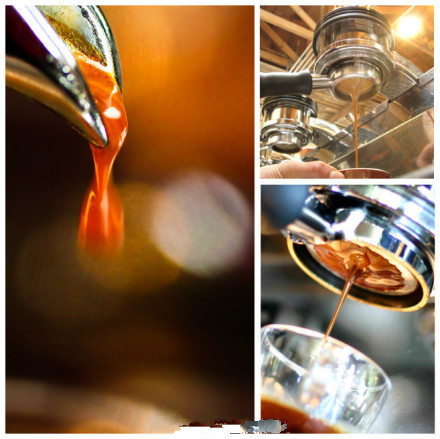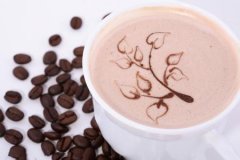Italian condensed basic knowledge what is Crema

During the roasting process, a large amount of carbon dioxide is produced in the coffee beans, most of which will be emitted during the cooling process, a few will continue to be kept inside, and the grinding will release these gases, so coffee must be made as soon as possible after grinding.
When hot water hits coffee powder under high pressure, it will emulsify the insoluble oil of coffee powder and dissolve a large amount of carbon dioxide supersaturated, which is much larger than the solubility of hot water under normal pressure. this is why countless small foams immediately appear when the liquid flows from the handle. But this does not fully explain the "Crema", open a can of Coke, we can see countless bubbles coming up, but they simply do not last.

To produce stable bubbles, we need some bubbles and some compounds to "wrap" the bubbles, making the bubble structure stable and elastic. The process of this chemical reaction can be thought of as the role of a surfactant. Unlike milk bubbles, which do this through egg whites, coffee uses a substance called protein melanin. It is produced by a chemical reaction of a group of mixtures during baking. In fact, scientists do not know much about the process. Neither protein nor melanin is hydrophilic, so when hot water strikes, they are naturally distributed on the surface of bubbles, so they can come into contact with more air, resulting in countless small bubbles, so we have-bubbles. There are other things-fat (the author refers to both oil and fat, fat is solid, oil is liquid), the presence of oil often destroys the structure of foam (think about it, when we make a cake, we have to remove the yolk, otherwise the fat in the yolk will lead to the failure of egg whites (that is, quickly stirring egg whites and beating them into milk bubbles).
So will the oil in the coffee cause crema to disappear quickly in a few minutes? The answer is both right and wrong. The surfactant is dissolved in water, and due to the action of gravity, the surfactant of the bubble surface will be pulled off the surface of the foam together with the water, making the foam fragile, robbing elasticity, and then quickly disappearing. The speed at which the foam disappears is related to the speed at which the water is dragged away, but the foam on the surface of a cup of coffee lasts much longer than the foam on the surface of a cup of coffee, because the liquid is much thicker than it is quickly flushed. This is also confirmed by our taste.
What does the color of Crema tell us?

Extract the color of insufficient espresso Crema

Color of over-extracted espresso Crema
I once said that the color of crema should be light reddish brown, but what does yellow-white or very black almost charred brown mean? The answer comes from drinks, because crema is actually carbon dioxide bubbles wrapped in brewed coffee, so the darker the foam means the stronger the coffee becomes a natural assumption. But it's actually very difficult to tell the color of coffee unless you dilute two cups of coffee or look at it under a microscope.
Another factor also plays an important role: the reflection of light from the foam means that the color of the coffee is much lighter than it actually is through the foam. And the smaller the foam, the greater the effect, so even if the espresso itself is very black, it may look very light (which explains why black beer has very white foam at the top).
A 15-second espresso usually has a whiter crema because it is lighter. Coffee powder is quenched by water for a relatively short time, and the viscosity of coffee is lower than that washed out in 25 seconds. For the same reason, coffee made from a lower water temperature will be lighter because it does not have enough energy to dissolve the substance in the coffee (it should be low solubility at low water temperature, not so-called energy). This also explains why excessive quenching can lead to the formation of crema that is as dark as charred.
Arabica coffee vs Roberta
There has long been a theory that Roberta can produce better crema during stamping. This is true because the aroma composition and aromatic oil content of Roberta is only half that of Arabica coffee. This means that less oil is quenched into coffee, thus reducing the effect of oil on foam stability, so increasing Roberta will reduce the overall amount of oil quenched from coffee powder, which means you have a higher chance of producing a more stable and richer Crema.
Food technologists will also tell you that reducing the amount of oil will make more body at the beginning of making coffee, and the lack of oil will cause the coffee to be different from that made from Arabica coffee. Therefore, it is generally adopted to add 5% of 10% Robosta, which will not significantly affect the quality of coffee, but can ensure the stability of crema. However, this theory can not explain the source of the additional crema. Other articles have explained that Roberta may contain different sugars, thus leading to this change.
I often collect some espresso with unique crema. A special case comes from "Yellow Bourbon" produced by a farm in Brazil. It tastes so sweet that if it is used to make espresso, even if it is baked nine days ago, it can still produce very rich and stable crema. Even when the liquid of the dry coffee is poured and the foam dries, it is still stable.
There are a variety of uncertainties that affect crema. In summary, it is how coffee preserves the foam of carbon dioxide, how many kinds and how many oils there are in coffee, and how they are quenched into the cup.

Tiger spots / markings
We often say that there must be red markings on the surface of the coffee. Spots are actually very fine ground coffee powders that are washed out in the early stages of the production process. I can often see them spread over the edge of the cup at first, and then spread over the whole surface with the process of punching. This implies that this cup is not only well made, but also well ground and is suitable for making espresso.
If the grinding is very consistent, it will have the opposite effect as expected, and it is difficult to combine the coffee powder closely. For example: one pool is full of volleyball, another pool, full of volleyball, football, tennis mixture, who will be denser. If each piece of coffee powder has a different shape and size and can be locked together, of course there is still some room for the water to flow normally.
In the cup, the tiger stripe means that the ground coffee powder is in the right range (which explains why the bean grinder is not set as fine as possible).

What Crema can tell us what can't tell us:
Crema can tell us:
1. Whether the coffee is fresh or not: a large number of Robosta beans allow us to see a lot of foam, so we can't judge the freshness of coffee by watching the speed at which the foam disappears. Fresh coffee will appear to be very crema throughout the production process (that is, when the coffee comes out, it looks like Coke spurting out), and only when a large amount of water appears, it will stop, thus dividing into two very obvious stages. Old coffee will often see a thin, separate foam in the process of ejection. The resulting coffee is often thin and watery, which means less crema and disappears faster.
2. The degree of coffee quenching: the deeper the Crema, the more dissolved matter enters the cup.
3. Uniformity of coffee quenching: the more stable the Crema, the better and stronger the coffee we make, which means that there are fewer gaps in the coffee powder and fewer mistakes in the production process.
What Crema can't tell us:
1. Whether the coffee is good or not: as long as it is fresh enough, no matter how bad the beans are, no matter how bad the roast can produce rich crema.
2. The oil in coffee is properly emulsified: for a long time, many people, including I thought, Crema told us the degree of quenching of oil in coffee, but the theory tells us that more oil, less foam. If you try making espresso with 5-6bar pressure, you will find that you can still make a lot of crema, but the coffee tastes very insipid because of lack of oil and aroma.
Crema, it's not complicated at all.
The production of Espresso and crema is often complicated, far more than is actually needed. Crema is a very simple part of the whole espresso production process. (the author has made some concluding remarks below. I will not translate them one by one and summarize them directly.)
Espresso has three main elements, one is water, the second is oily, and the third is foam. While the espresso body is gelatinous (the legendary soy sauce paste), the oil in the coffee is emulsified by hot water at high temperature and high pressure to form a colloid, which is extremely stable. The foam on the surface of espresso disappears very quickly compared to the colloid.
After eliminating the mysterious aura shrouded in Crema, Crema is still a great pleasure of espresso. Its honeycomb structure stores a lot of aromatic substances, releases a large amount of fragrance when the structure disintegrates, and brings enjoyment to our vision and smell at the same time.
Important Notice :
前街咖啡 FrontStreet Coffee has moved to new addredd:
FrontStreet Coffee Address: 315,Donghua East Road,GuangZhou
Tel:020 38364473
- Prev

Drip coffee Kalita analysis of fine coffee common sense
Filter paper brewing Italian coffee popular today, seems to have been forgotten, at the same time because filter paper brewing is not so ornamental siphon, nor is it as rich as the French press coffee extraction, so now really like filter paper brewing way of gluttony rare. However, filter paper brewing method is one of my daily compulsory courses. There are 3 reasons: 1, filter paper brewing for coffee beans and phase
- Next

Common sense of how to choose fancy Coffee partner for Dairy products
The earliest encounter between coffee and milk dates back to the 17th century. It is said that Turks never drink milk in their coffee because they are generally lactose intolerant. Later, a Venetian named Johamnes Diodato invented this method, and he is also the now famous inventor of praises bread. At present, there are many dairy products on the market that can be paired with coffee.
Related
- Beginners will see the "Coffee pull flower" guide!
- What is the difference between ice blog purified milk and ordinary milk coffee?
- Why is the Philippines the largest producer of crops in Liberia?
- For coffee extraction, should the fine powder be retained?
- How does extracted espresso fill pressed powder? How much strength does it take to press the powder?
- How to make jasmine cold extract coffee? Is the jasmine + latte good?
- Will this little toy really make the coffee taste better? How does Lily Drip affect coffee extraction?
- Will the action of slapping the filter cup also affect coffee extraction?
- What's the difference between powder-to-water ratio and powder-to-liquid ratio?
- What is the Ethiopian local species? What does it have to do with Heirloom native species?

